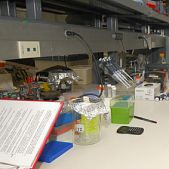
Greek scientist grew part of the human stomach in laboratory
Scientists looking to understand human stomach diseases can now use an artificially grown tissue designed to recreate the normal processes of the organ such as producing acids and other digestive enzymes. In a study featured in the journal Nature, researchers from the Cincinnati Children’s Hospital Medical Center, among them a Greek researcher, were able to grow human tissues in a laboratory using samples taken from the corpus/fundus region of the stomach.
The breakthrough comes two years after the group successfully cultivated another part of the stomach known as the antrum, which produces hormones for the organ.
The discovery means investigators now can grow both parts of the human stomach to study disease, model new treatments and understand human development and health in ways never before possible.
“Now that we can grow both antral- and corpus/fundic-type human gastric mini-organs, it’s possible to study how these human gastric tissues interact physiologically, respond differently to infection, injury and react to pharmacologic treatments,” said Jim Wells, PhD, principal investigator and director of the Pluripotent Stem Cell Facility at Cincinnati Children’s. “Diseases of the stomach impact millions of people in the United States and gastric cancer is the third leading cause of cancer-related deaths worldwide.”
Researchers now plan to study the ability of tissue-engineered human stomach organoids to model human gastric diseases by transplanting them into mouse models. In particular, Wells and his collaborator Yana Zavros, PhD, associate professor at the University of Cincinnati, want to explore how the fundus organoids respond after being infected with H. (Helicobacter) pylori bacteria. H. pylori causes chronic gastritis, stomach ulcers and is a major risk factor for the development of stomach cancer.
The current study caps a series of discoveries since 2010 in which research teams led or co-led by Wells used human pluripotent stem cells (hPSC) – which can become any cell type in the body – to engineer regions of the human stomach and intestines. They are using the tissues to identify causes and treatments for diseases of the human gastrointestinal tract.
This includes a study published Nov. 21, 2016 by Nature Medicine, in which scientists generated human intestine with an enteric nervous system. These highly functional tissues are able to absorb nutrients and demonstrate peristalsis, the intestinal muscular contractions that move food from one end of the GI tract to the other.
The primary focus of Wells’ laboratory is to study how organs form during embryonic development. This includes the esophagus, stomach, pancreas and intestines. Wells and his colleagues have a particular interest in finding new treatments for genetic forms of diseases like monogenic diabetes and Hirschsprung’s disease.
Read also:
Yana Zavros: She created the first functional 3D stomach tissue










